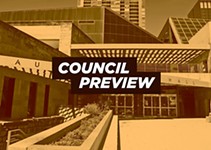Council on CodeNEXT
Four CMs lament inequitable land use standards throughout city
By Michael King, Fri., Aug. 25, 2017

There's no regular City Council meeting this week (the next is Aug. 31), although council members continue budget preparation, with departmental and related reviews (Wednesday mornings) and now increasing attention to the "Concept Menu" – the annual wish list of increases/reductions that is compiled in progress, and then winnowed in the schedule's final, early September days.
Just about the time of budget "readings" – the formal adoptions are scheduled for Sept. 11-13 – council members will also be expecting the next draft of CodeNEXT, the land use code revisions that have been in the works for years. Tuesday morning at Blazier Elementary School, in far Southeast District 3, four council members – Delia Garza, Pio Renteria, Greg Casar, and Jimmy Flannigan – fired a shot across the dais, challenging city staff and their colleagues to produce a code "for all Austinites," and to substantively address affordability, gentrification, residential displacement, and the increasing economic segregation of the city.
Blazier, about 10 years old, is on Vertex Blvd. at the literal eastern end of Slaughter Lane, and now across the road from the rapidly growing Goodnight planned unit development approved by Council some years ago. Renteria recalls picking cotton as a youth in the fields of what is now becoming a neighborhood. District 2 CM Garza explained that the school had been built for 600 students, now serves 960 (including portable classrooms), and is expected to be at 180% capacity by 2021. She said the spiraling outward of new development to spreading suburbs is a result of "a very inequitable system of how we zone, and what we allow to be zoned."
More specifically, Garza said, most zoning and code arguments at Council far too often concern residential "character," defined architecturally as "building dimensions, fence lines, setbacks," and other appearances. Recalling a family quinceañera in her own South Austin neighborhood, she said she wants the code to encourage a different sort of neighborhood "character": "diversity, family, and culture." People in her district, she said, "don't want to have to move out of Austin to achieve the American dream of owning a home."
The other CMs summarized different aspects of the land use code that they say are encouraging sprawl and gentrification instead of incentivizing affordability via density, transit-oriented development, or just simplification. Renteria noted that his Cesar Chavez area of District 3, where he has lived all his life, is mostly emptied of his childhood friends, who have been forced to move to cheaper suburbs. Unlike Blazier, he said, "Our schools are underenrolled and expecting consolidation." The only way to accomplish family affordability, Renteria said, is a code that encourages greater density. "I'm tired of fighting gentrification on a case-by-case basis."
Flannigan noted that even his relatively suburban, far northwest District 6, is suffering residential displacement, with people moving even farther out of the city or forced to drive long distances for work. He said the code incentivizes sprawl, requires expensive infrastructure to service that sprawl, and is "broken in both big and small ways."
"The complexity of this code exacerbates our affordability issues," Flannigan said, "and it only gives access to the privileged few, who have the time, money, and lobbyists to understand it."
CM Casar added the necessity of mass transit incentives in the code – so that the whole city becomes more accessible and less vehicle-bound – and added that CodeNEXT needs to integrate fair housing standards throughout its requirements. "We need to be able to build affordable housing for working families in high opportunity areas," he said, a term used to describe close-in neighborhoods with a high quality of life and direct access to resources and amenities not available in suburban developments.
Yet it is precisely those neighborhoods – primarily on the west side, largely single-family residential – that have been strongly resisting changes to the code that might encourage more affordable housing either within their boundaries or along major corridors. The council members suggested that while those neighborhoods have more ready access to Council chambers, the time to employ it, and influence on the dais, they do not necessarily represent the working families under the most pressure of gentrification and displacement.
Casar said, "Our current code is unacceptable, and the current draft of CodeNEXT is seriously deficient. It is not working for everyday Austinites, and it is failing working families. We are committed to charting a new path," he concluded, "and a land use code that works for all Austinites, and not just a privileged few."
All four council members said that if the next draft of CodeNEXT (scheduled for mid-September) does not substantively address affordability and discourage gentrification and displacement, they would demand greater changes in the eventual final draft. And if they cannot persuade their colleagues to join them in that effort, they said, they would not be able to vote for the new code next spring.
Got something to say on the subject? Send a letter to the editor.










